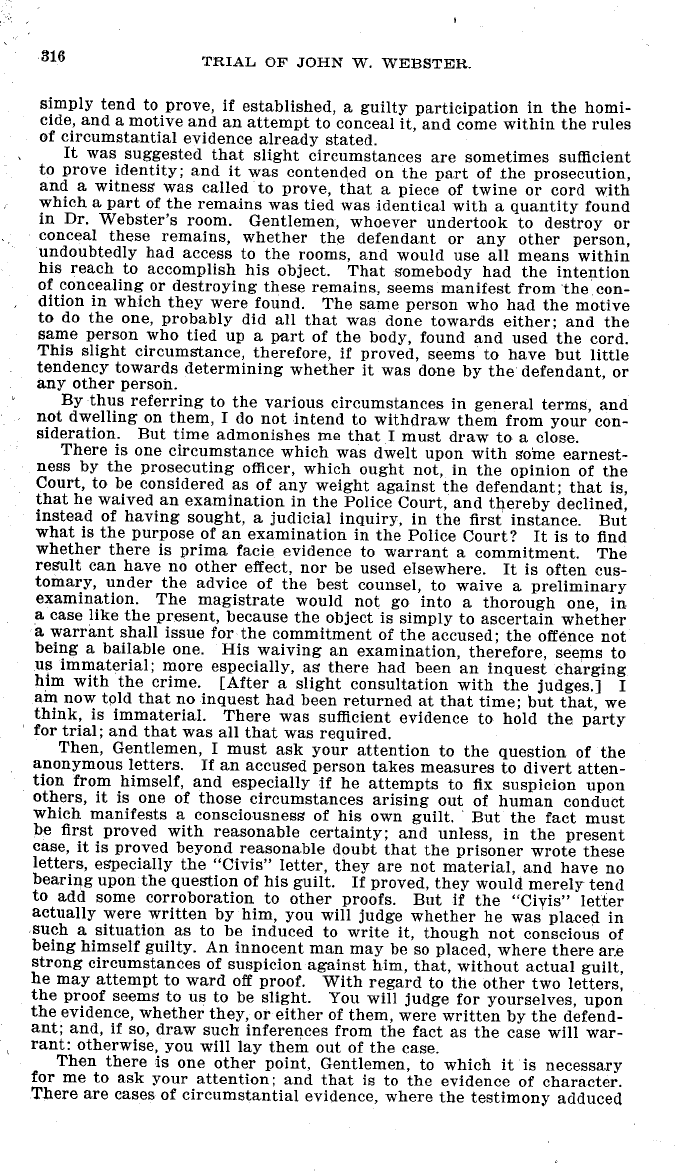|
316
TRIAL OF JOHN W. WEBSTER.
simply tend to prove, if established, a guilty participation in the homi-
cide, and a motive and an attempt to conceal it, and come within the rules
of circumstantial evidence already stated.
It was suggested that slight circumstances are sometimes sufficient
to prove identity; and it was contended on the part of the prosecution,
and a witness was called to prove, that a piece of twine or cord with
which a part of the remains was tied was identical with a quantity found
in Dr. Webster's room. Gentlemen, whoever undertook to destroy or
conceal these remains, whether the defendant or any other person,
undoubtedly had access to the rooms, and would use all means within
his reach to accomplish his object. That somebody had the intention
of concealing or destroying these remains, seems manifest from the.con-
dition in which they were found. The same person who had the motive
to do the one, probably did all that was done towards either; and the
same person who tied up a part of the body, found and used the cord.
This slight circumstance, therefore, if proved, seems to have but little
tendency towards determining whether it was done by the defendant, or
any other person.
By thus referring to the various circumstances in general terms, and
not dwelling on them, I do not intend to withdraw them from your con-
sideration. But time admonishes me that I must draw to a close.
There is one circumstance which was dwelt upon with some earnest-
ness by the prosecuting officer, which ought not, in the opinion of the
Court, to be considered as of any weight against the defendant; that is,
that e waived an examination in the Police Court, and thereby declined,
instead of having sought, a judicial inquiry, in the first instance. But
what is the purpose of an examination in the Police Court? It is to find
whether there is prima facie evidence to warrant a commitment. The
result can have no other effect, nor be used elsewhere. It is often cus-
tomary, under the advice of the best counsel, to waive a preliminary
examination. The magistrate would not go into a thorough one, in
a case like the present, because the object is simply to ascertain whether
a warrant shall issue for the commitment of the accused; the offence not
being a bailable one. His waiving an examination, therefore, seems to
us immaterial; more especially, as there had been an inquest charging
him with the crime. [After a slight consultation with the judges.] I
am now told that no inquest had been returned at that time; but that, we
think, is immaterial. There was sufficient evidence to hold the party
for trial; and that was all that was required.
Then, Gentlemen, I must ask your attention to the question of the
anonymous letters. If an accused person takes measures to divert atten-
tion from himself, and especially if he attempts to fix suspicion upon
others, it is one of those circumstances arising out of human conduct
which manifests a consciousness of his own guilt. But the fact must
be first proved with reasonable certainty; and unless, in the present
case, it is proved beyond reasonable doubt that the prisoner wrote these
letters, especially the "Civis" letter, they are not material, and have no
bearing upon the question of his guilt. If proved, they would merely tend
to add some corroboration to other proofs. But if the "Ciyis" letter
actually were written by him you will judge whether he was placed in
such a situation as to be induced to write it, though not conscious of
being himself guilty. An innocent man may be so placed where there are
strong circumstances of suspicion against him, that, without actual guilt,
he may attempt to ward off proof. With regard to the other two letters,
the proof seems to us to be slight. You will judge for yourselves, upon
the evidence, whether they, or either of them, were written by the defend-
ant; and if so, draw such inferences from the fact as the case will war-
rant: otherwise, you will lay them out of the case.
Then there is one other point, Gentlemen, to which it is necessary
for me to ask your attention; and that is to the evidence of character.
There are cases of circumstantial evidence, where the testimony adduced
|

